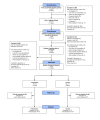Impact of MyDiabetesPlan, a Web-Based Patient Decision Aid on Decisional Conflict, Diabetes Distress, Quality of Life, and Chronic Illness Care in Patients With Diabetes: Cluster Randomized Controlled Trial
- PMID: 32996893
- PMCID: PMC7557444
- DOI: 10.2196/16984
Impact of MyDiabetesPlan, a Web-Based Patient Decision Aid on Decisional Conflict, Diabetes Distress, Quality of Life, and Chronic Illness Care in Patients With Diabetes: Cluster Randomized Controlled Trial
Abstract
Background: Person-centered care is critical for delivering high-quality diabetes care. Shared decision making (SDM) is central to person-centered care, and in diabetes care, it can improve decision quality, patient knowledge, and patient risk perception. Delivery of person-centered care can be facilitated with the use of patient decision aids (PtDAs). We developed MyDiabetesPlan, an interactive SDM and goal-setting PtDA designed to help individualize care priorities and support an interprofessional approach to SDM.
Objective: This study aims to assess the impact of MyDiabetesPlan on decisional conflict, diabetes distress, health-related quality of life, and patient assessment of chronic illness care at the individual patient level.
Methods: A two-step, parallel, 10-site cluster randomized controlled trial (first step: provider-directed implementation only; second step: both provider- and patient-directed implementation 6 months later) was conducted. Participants were adults 18 years and older with diabetes and 2 other comorbidities at 10 family health teams (FHTs) in Southwestern Ontario. FHTs were randomly assigned to MyDiabetesPlan (n=5) or control (n=5) through a computer-generated algorithm. MyDiabetesPlan was integrated into intervention practices, and clinicians (first step) followed by patients (second step) were trained on its use. Control participants received static generic Diabetes Canada resources. Patients were not blinded. Participants completed validated questionnaires at baseline, 6 months, and 12 months. The primary outcome at the individual patient level was decisional conflict; secondary outcomes were diabetes distress, health-related quality of life, chronic illness care, and clinician intention to practice interprofessional SDM. Multilevel hierarchical regression models were used.
Results: At the end of the study, the intervention group (5 clusters, n=111) had a modest reduction in total decisional conflicts compared with the control group (5 clusters, n=102; -3.5, 95% CI -7.4 to 0.42). Although there was no difference in diabetes distress or health-related quality of life, there was an increase in patient assessment of chronic illness care (0.7, 95% CI 0.4 to 1.0).
Conclusions: Use of goal-setting decision aids modestly improved decision quality and chronic illness care but not quality of life. Our findings may be due to a gap between goal setting and attainment, suggesting a role for optimizing patient engagement and behavioral support. The next steps include clarifying the mechanisms by which decision aids impact outcomes and revising MyDiabetesPlan and its delivery.
Trial registration: ClinicalTrials.gov NCT02379078; https://clinicaltrials.gov/ct2/show/NCT02379078.
Keywords: decision aid; decisional conflict; diabetes distress; diabetes mellitus; goals of care; patient assessment of chronic illness care; quality of life; randomized clinical trials; shared decision making.
©Catherine Yu, Dorothy Choi, Brigida A Bruno, Kevin E Thorpe, Sharon E Straus, Paul Cantarutti, Karen Chu, Paul Frydrych, Amy Hoang-Kim, Noah Ivers, David Kaplan, Fok-Han Leung, John Maxted, Jeremy Rezmovitz, Joanna Sale, Sumeet Sodhi-Helou, Dawn Stacey, Deanna Telner. Originally published in the Journal of Medical Internet Research (http://www.jmir.org), 30.09.2020.
Conflict of interest statement
Conflicts of Interest: None declared.
Figures
References
-
- Santana MJ, Manalili K, Jolley RJ, Zelinsky S, Quan H, Lu M. How to practice person-centred care: a conceptual framework. Health Expect. 2018 Apr;21(2):429–40. doi: 10.1111/hex.12640. http://europepmc.org/abstract/MED/29151269 - DOI - PMC - PubMed
-
- Williams JS, Walker RJ, Smalls BL, Hill R, Egede LE. Patient-centered care, glycemic control, diabetes self-care, and quality of life in adults with type 2 diabetes. Diabetes Technol Ther. 2016 Oct;18(10):644–9. doi: 10.1089/dia.2016.0079. http://europepmc.org/abstract/MED/27541872 - DOI - PMC - PubMed
-
- Scholl I, Zill JM, Härter M, Dirmaier J. An integrative model of patient-centeredness - a systematic review and concept analysis. PLoS One. 2014;9(9):e107828. doi: 10.1371/journal.pone.0107828. https://dx.plos.org/10.1371/journal.pone.0107828 - DOI - DOI - PMC - PubMed
-
- Mullan RJ, Montori VM, Shah ND, Christianson TJH, Bryant SC, Guyatt GH, Perestelo-Perez LI, Stroebel RJ, Yawn BP, Yapuncich V, Breslin MA, Pencille L, Smith SA. The diabetes mellitus medication choice decision aid: a randomized trial. Arch Intern Med. 2009 Sep 28;169(17):1560–8. doi: 10.1001/archinternmed.2009.293. - DOI - PubMed
Publication types
MeSH terms
Associated data
LinkOut - more resources
Full Text Sources
Medical
Miscellaneous


